Microsoft and Nokia 'should be lauded' for bringing Windows Phone to market, says ustwo
Risky venture a designer's dream

As Microsoft and Nokia have both discovered, communicating the ins and outs of Windows Phone's UI to an audience used to iOS and Android has been no easy feat.
Whale Trail developer ustwo, however, believes the platform's willingness to take risks – its move away from rows of apps and Apple's Helvetica bent – should be celebrated.
According to the studio - which has a handle on UI thanks to its efforts in the digital design arena – Windows Phone's efforts to do things differently is helping it to become "the third platform" for smartphone developers.
A Windows winner"Microsoft should be lauded for taking a risk in bringing its unique Windows Phone 7 to the consumer, and Nokia in turn for choosing it as their flagship smartphone OS," says account director Liana Chang on the studio's blog.
"iOS and Android may perform well as mini computers, but Windows Phone is the only smartphone OS that has truly been designed primarily around the human need to communicate."
Success on Windows Phone from a design perspective, however, relies on developers embracing the clean approach of the platform. Those who don't, it's claimed, risk delivering cold or clunky apps.
"Having a strong overarching system identity requires adherence to its principles for it to work platform wide, and these can be problematic for brands with strong, almost dictatorial visual identities and for designers and developers who use applications as showcases for personal creativity," adds Chang.
Different by design
Chang cites examples on both sides of the divide, but in particular, points out how using the "strong typographic underpinning WP7 borrowed from Zune offers a better base to build an app from" than on rival platforms.
"Comparing the WP7 version of the Bank of America app to the iOS version, the WP7 version is clean and elegant, giving the user a sense of stability, whereas the iOS version is clunky and doesn't inspire the user with confidence," states Chang.
"Both apps, as far as we can tell, use standard UI elements out of the box."

In the end it will be sales that decide Windows Phone's fate, but for those looking to ride its rising wave, rehashing apps from rival platforms just won't do.
"We're setting this as a challenge to ourselves and other designers out there to not approach applications on the platform as simply trying to recreate what's been done on iOS or Android or as just another lazy porting job," concludes Chang.
[source: ustwo]
